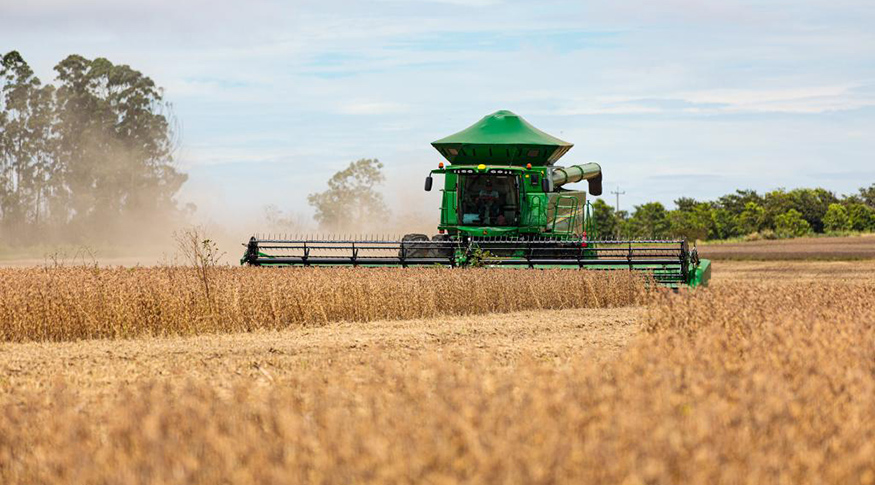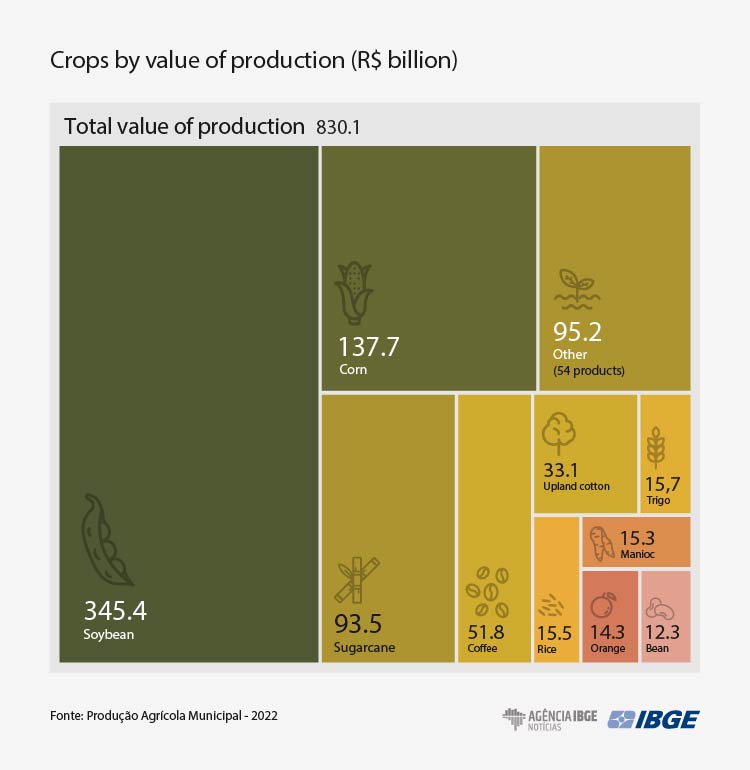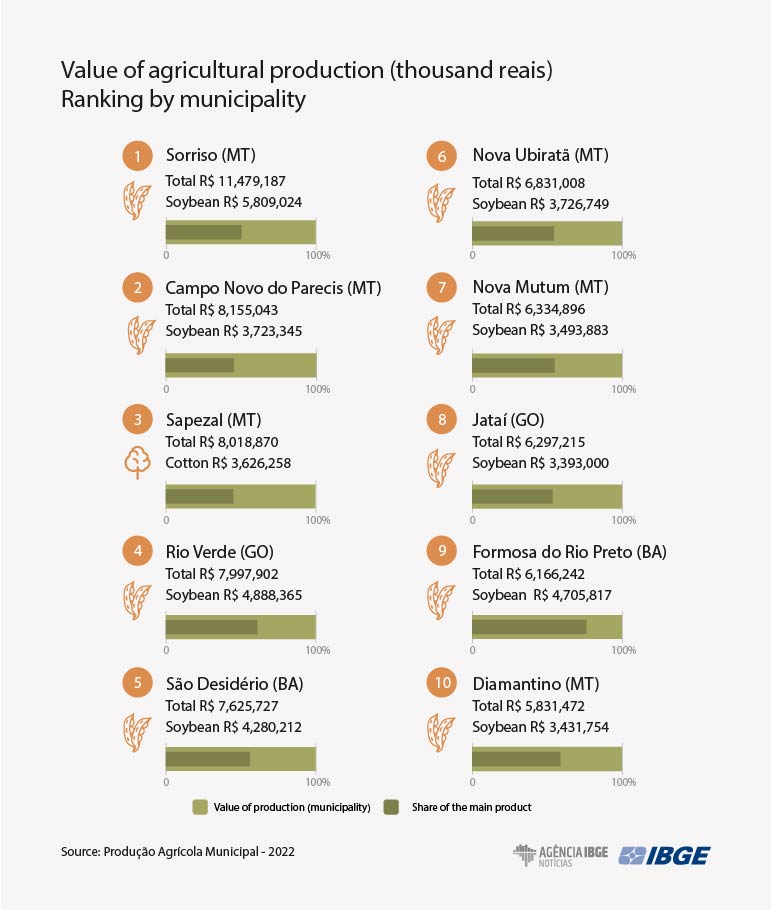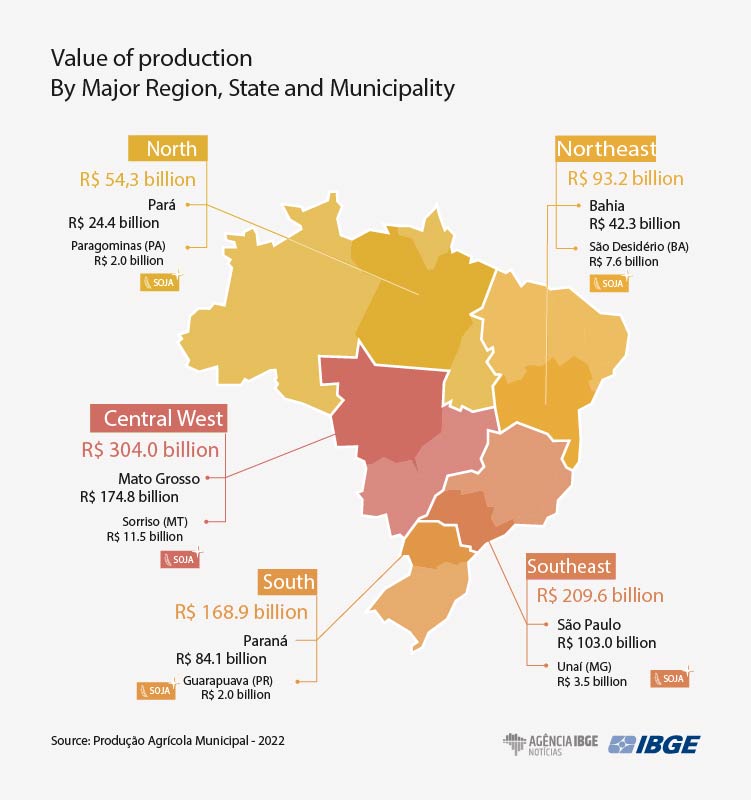PAM
In 2022, Sorriso (MT) remains as the number one agricultural producer in the country
September 14, 2023 10h00 AM | Last Updated: September 19, 2023 02h10 PM
Highlights
- In 2022, the value of agricultural production in Brazil hit a record figure of R$ 830.1 billion, with an increase of 11.8% from 2021. The production of grain increased by 3.8% and hit a record of 263.8 million metric tons.
- Mato Grosso recorded the highest value of production, with R$ 174.8 billion, an annual increase of 15.2%, followed by São Paulo (R$ 103.0 billion and an increase of 22.5%) and Minas Gerais (R$ 87.3 billion and an increase of 28.1%).
- Sorriso (MT) was the leading municipality for the fourth consecutive year, with R$ 11.5 billion, an increase of 15.2% from 2021. It is followed by Campo Novo do Parecis (MT) (R$ 8.2 billion and an increase of 7.9%) and Sapezal (MT) (R$ 8.0 billion and a decrease of 11.5%).
- With a total 120.7 million tonnes, the production of soybeans dropped by 10.5% in 2022, but value of production increased by 1.3% and reached R$ 345.4 billion. Among the municipalities, the main producers were Sorriso (MT), with 2.1 million tonnes, Rio Verde (GO), with 1.64 million tonnes, and Formosa do Rio Preto (BA), with 1.58 million tonnes.
- Corn crops increased by 24.0%, and amounted to 109.4 million tonnes. The value of agricultural production amounted to R$ 137.7 billion, with an increase of 18.6%. The three municipalities accounting for the biggest amounts produced are located in Mato Grosso. Sorriso (3.8 million tonnes), Nova Ubiratã (2.14 million tonnes) and Nova Mutum (1.95 million tonnes).
- The production of sugarcane reached 724.4 million tonnes, with an increase of 1.2%. The value of production increased by 24.2% and reached R$ 93.5 billion. The leaders of output were Uberaba (MG), with 9.7 million tonnes, Barretos (SP) with 6.64 million tonnes, and Quirinópolis (GO), with 6.59 million tonnes.
- The production of coffee increased by 6.3% and reached 3.2 million tonnes. Value of production increased by 48.8% and hit r4 51.8 billion. Rio Bananal (ES), São Miguel do Guaporé (RO) and Linhares (ES) are on top with, respectively, 48.5 thousand tonnes, 44.0 thousand tonnes and 43.7 thousand tonnes.

Value of production and grain harvest hit record figures in 2022
The value of production of the main agricultural crops in Brazil hit a record of r$ 830.1 billion in 2022, with an increase of 11.8% in relation to the previous year. That was the biggest grain harvest ever registered in this time series, 263.8 million tonnes, an increase of 3.8% from 2021. The area planted in the country amounted to 91.1 million hectares, with an increase of 5.2%, or 4.5 million hectares more than in 2021. The data can be found in the Municipal Agricultural Production, released today (14) by the IBGE.
“With the limitation to trade affecting the main agricultural commodities, due to conflicts between Russia and Ukraine, and the dollar keeping its value against the real, the prices of the main agricultural products remained high,” say Winicius Wagner, supervisor of the survey./p>
With the good performance, mainly of the second crop, and the new record of the time series, corn crops were the ones accounting for the increase of value of production in the year, having reached 109.4 million tonnes and generating R$ 137.7 billion, with an increase of 18.6% from 2021.
As for value of production, soybean was the leader. In spite of the drop of 10.5% in production in 2022, with a volume of 120.7 million tonnes, the value of oilseeds increased by 1.3% from 2021, and reached R$ 345.4 billion. The items that followed were corn, sugarcane, coffee and cotton.
“Besides the record production of grain, the continuation of a level of high prices for the main agricultural commodities in the iinternational market added to an increase of 6.6% in value of production of cereals, legumes and oilseeds, a record of R$ 568.2 billion,” Mr. Wagner adds. With a participation of 30.2% in the national production of grain, Mato Grosso was, once again, the main producer, followed by Paraná, Goiás and Rio Grande do Sul.

Mato Grosso is still the leader, with 21.1% of the value of agricultural production
As the biggest producer of soybean, corn and cotton, Mato Grosso was the Federation Unit with the highest value of agricultural production. In 2022, production in the state generated R$ 174.8 billion, an increase of 15.2%. Mato Grosso increased its national participation to 21.1%, and now is ahead of São Paulo. The state accounts for more than 1/5 of the value of national agricultural production.
São Paulo recorded an increase of 24.6% in the value of production of sugarcane and of 16.4% in the value of production of orange, products that have São Paulo as the number one in production. In general, the increase was 22.5%, resulting in value of production of R$ 103.0 billion. The participation of the state, which had been 11.3% in 2021, reached 12.4% in 2022. Minas Gerais, the biggest producer of coffee, was in the third position, with R$ 87.3 billion, an increase of 28.1%.
Among the municipalities, Sorriso (MT) was the leader for the fourth consecutive time, having reached R$ 11.5 billion in value of production and accounting for 1.4% of the national overall. Sorriso also accounted for the main value of production of soybean (R$ 5.8 billion) and corn (R$ 4.2 billion). This municipality was also the number five producer of upland cotton (seed), generating R$ 1.3 billion, and the fourth biggest producer of bean, with 46,350 tonnes, generating R$ 152.5 million.
Campo Novo do Parecis (MT) was in the second position, amounting to R$ 8.2 billion, an increase of 7.9% from 2021. The production of soybean, cotton and corn amounted to R$ 7.8 billion. In the year, Campo Novo do Parecis generated R$ 2.2 billion from the production of corn, and was the number three in the production ranking of corn in the country.
Sapezal (MT), number three in the list, had a value of production of R$ 8.0 billion, with a retreat of 11.5% against the previous year. The municipality stood out as for the production of upland cotton, with the highest value resulting from corn production, approximately R$ 3.6 billion. Besides, it was the number six national producer of soybean, with R$ 3.4 billion.

Severe drought in the South affects soybean production
In 2022, the drought in Rio Grande do Sul, Paraná and Mato Grosso do Sul, caused the average yield of soybean to drop by 14.3% from the previous harvest. Despite the increase in planted area, the soybean output fell by 10.5% from 2021, and reached 120.7 million tonnes. Value of production increased by 1.3%, and amounted to R$ 345.4 billion. So, soybean was the number one among the cereals, legumes and oilseeds, accounting for 60.8% of the value of production in this group.
According to the supervisor of the survey, “the attractive prices of this grain in the last few harvests once more added to the expansion of planting areas by producers. Therefore, there was an increase of 5.1% in planted area in the year, with an increase of almost two million hectares.”
With 38.0 million tonnes and an increase of 7.6% in the year, Mato Grosso is the main producer. Goiás follows, with 15.2 million tonnes and an increase of 11.4%. Among the municipalities, the main producers were Sorriso (MT), with 2.1 million tonnes, Rio Verde (GO), with 1.64 million tonnes, and Formosa do Rio Preto (BA), with 1.58 million tonnes.
Soybean exports dropped by 8.6%, and amounted to 78.7 million tonnes. In spite of that, according to the Secretariat of Foreign Trade (SECEX), the product was the leader of exports in 2022, and had a participation of 13.9% of the total exports in Brazil this year.
Second crop has record output of corn
Driven by the good performance of the second crop, the national production of corn recovered in 2022. A total of 109.4 million tonnes were produced, an increase of 24.0% (21.1 million tonnes). That is a reaction after the damage of the previous crop with the drought that happened in the Central-South of Brazil in the fall and winter months, having an impact on the 2nd national crop.
The attractive prices charged in the end of 2020 and the first semester of 2021 caused producers to expand planting areas, which hit a record of 21.3 million hectares, an increase of 8.9%. Corn, which accounted for 41.5% of the overall production of cereals, legumes and oilseeds in the country, and its value added increased by 18.6%, amounting to R$ 137.7 billion.
Planted area in the first crop increased by 3.8%, and was close to 5.2 million hectares.
The second crop of corn increased by 10.6% in planted area and an increment of 18.9% in average yield. That means a recovery from the result of 2021. The volume produced amounted to 84.4 million tonnes, an increase of 34.4%. As a result, the second crop hit a record figure, and increased the participation of corn to 77.2% of the total produced in Brazil.
According to SECEX, the year of 2022 hit a record figure in the national export of corn. There was an increase of 111.4% in volume of exported corn, reaching a total of 43.2 million tonnes. Iran was the main Destination of Brazilian corn, having received 16.5% of the total shipped.
With an increase of 19.6% and almost entirely produced in the second crop, Mato Grosso remained in the first position in the ranking of corn production, having reached 38.3 million tonnes. The prices of the grain, which started the first quarter at an upward trend, fell during the year and had a direct effect on the value of production of Mato Grosso, which increased by 9.4% and reached R$ 42.1 billion. Paraná, the number two in the list, recovered significantly from 221, with an increase of 47.8% in the volume produced, having generated R$ 20.4 billion as for value of production, with an increase of 35.7%.
The three municipalities with the biggest production in the country come from Mato Grosso: Sorriso (3.8 million tonnes), Nova Ubiratã (2.14 million tonnes) and Nova Mutum (1.95 million tonnes).
Sugarcane regains productivity despite reduction in planted area
Soybean, the number three product in terms of Generation of value in 2022, sugarcane dropped by 1.0% in planted area, approximately 100 thousand hectares. Even so, there was an increase of 1.2% in output, amounting to 724.4 million tonnes. Value of production stood at R$ 93.5 billion, an increase of 24.2% from the previous year.
The lowest global supply of sugar, the appreciation of the real Against the dollar and the significant rise in petroleum prices, account, in part, for the rise of sugarcane prices. “The reduction of areas for sugarcane plantations, in order to be used for grain crops, is a process that has been observed for some Years, since they have generated better profits to producers,” says Mr. Wagner. The municipalities with the biggest outputs are Uberaba (MG), with 9.7 million tonnes, Barretos (SP) with 6.64 million tonnes and Quirinópolis (GO), with 6.59 million tonnes.
With the moderate increase in the production of sugarcane and the global economic downturn, sugar exports remained at the same level as in 2021, according to SECEX. On the Other hand, the exports of ethanol increased by 26.7%, due to the higher international demand. /p>
Production of coffee increases by 6.3%, but prices remain on an upward trend
The Brazilian production of coffee increased by 6.3%, and reached 3.2 million tonnes. The increase did not affect the behavior of coffee prices, which remained on an upward trend. Production increased, mainly, due to the good productivity of coffeea canephora, besides the expansion of 2.2% in total harvested area. In 2022, Brazil remained as the main producer and world exporter of coffee. Against 2021, the value of production increased by 48.8%, and reached R$ 51.8 billion.
Brazil exported 2.1 million tonnes of unroasted coffee (green), a drop of 6.6% from 2021. Minas Gerais accounted for 81.0% of these exports. With 20.1% of participation, the United States were the main importers of Brazilian coffee, followed by Germany.
As for the total volume of coffee produced in the country, almost 2.1 million tonnes were of the Arabic type, a volume that represented 66.0% of the total in 2022, showing its importance to national harvest. The value of production amounted to R$ 39.5 billion, an increase of 47.1% against 2021. On the other hand, the volume of coffea canephora increased by 7.3%, a total of 1.1 million tonnes, which generated R$ 12.3 billion. That was an increase of 54.4% from 2021. The municipalities of Rio Bananal (ES), São Miguel do Guaporé (RO) and Linhares (ES) are the main producers of coffee, respectively, 48.5 thousand tonnes, 44.0 thousand tonnes and 43.7 thousand tonnes.

With an increase in planted area, output of corn grows by 12.4%
After a drop in planted area and output in 2021, corn crops had a good performance in 2022, with an increase of 12.4% in the volume produced, amounting to 6.4 million tonnes (seed). Planted area increased by 20.4%, and reached 20.4%, with a total 1.6 million hectares, after the increase in the global demand for the product.
The sowing of summer crops in the ideal period for planting also helped increase the area planted with corn (2nd crop). “Despite the high resistance to water scarcity, the productivity of corn can be affected by drought; therefore, planting in the ideal period reduces risks to producers who decided to expand planting areas.”
The value of production of corn increased by 25.2% and amounted to R$ 33.1 billion. Brazil is one of the main world producers of fiber and the third main exporter. According to SECEX, in spite of the increase in domestic production, there was a drop of 10.6% in the exported volume of raw cotton, or by 1.8 million metric tons in the year. China was the main purchaser, with a participation of 29.5% in our exports of the product.
Mato Grosso (R$ 23.5 billion in value of production and an increase of 12.4% in the year) and Bahia (R$ 7.3 billion and an annual increase of 79.4%) led the national production of cotton. Both states, together, held 90.7% of planted area in the country. The three main cotton producers among the municipalities are Sapezal (MT), São Desidério (BA) and Campo Novo dos Parecis (MT) with outputs of 692.7 thousand tonnes, 488.3 thousand tonnes, and 423.5 thousand tonnes, respectively.
Rice is affected by water scarcity and production drops by 7.6%
The production of rice dropped once again in 2022. “The scarcity of rain in Rio Grande do Sul, in a year when temperatures were high, damaged the productivity of crops, since the majority depends on irrigation,” Mr. Wagner explains. Planted area decreased by 2.0% in planted are, a drop of 2.0% in planted area, of 3.8% in average yield and a decrease of 7.6% in output, which reached 10.8 million. The decrease of value of production was even higher: 18.9% against 2021, generating R$ 15.5 billion.
Being responsible for 71.2% of the national output, in Rio Grande do Sul the production of rice is highly technical, with flood irrigation. Even so, in 2022, the harsh weather caused productivity to drop by 6.1% from the previous year.
Nine out of ten municipalities accounting for the biggest producers of rice are Rio Grande do Sul. The three Leaders are Uruguaiana (683.4 thousand tonnes), Santa Vitória do Palmar (589.2 thousand tonnes) and Itaqui (453.8 thousand tonnes).
Wheat has record harvest of 10.3 million tonnes
The area planted with wheat increased by 14.1%, and led to a record harvest of 10.3 million tonnes, an increase of 31.3% versus 2021. The value of production of wheat reached R$ 15.7 billion, with an increase of 42.6%.
With a production of 5.3 million tonnes, which increased by 49.4% in the year, Rio Grande do Sul is still the main producer of wheat, having accounted for 51.2% of the national total. The Leading municipalities in terms of wheat production are Tibagi (PR), with 138.5 thousand tonnes; Cruz Alta (RS), with 128.7 thousand tonnes and Santa Bárbara do Sul (RS), with 126 thousand tonnes.


















